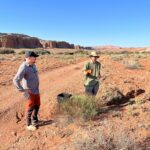by Marina Buqueras Rovira
ES
Sol 5
7 am Temprano en Marte, el Commander encabeza el despertar de la tripulación. Hoy nos espera una larga actividad extravehicular “EVA”. Chocolate con leche, zumo de naranja, galletas o cereales es nuestro desayuno.
9 am Andrea, David y Luis inician la misión EVA3, la importancia de su salida es conseguir capturar imágenes con el drone para así poder generar un ortomosaico en 3D para la EVA siguiente. Estuvieron casi 3 horas en pleno sol caminando por Candor Chasma, de vuelta Opportuniy y Perseverance, les regresan a la base cansados aunque entusiasmados!
Mientras la tripulación de la EVA3 examinaba la zona y cumplía con su misión, el resto preparaban el almuerzo con cariño.
12 pm Hoy tenemos arroz con lentejas y bacon, también espinacas con champiñones. Unos recuperan la fuerza y los demás cargan las pilas para la EVA4.
13:30 pm Tomás, Andrés y Marina, están listos para su misión. La eficacia de Luis hace posible que nuestra ruta estuviera perfectamente trazada en el mapa, también nos proporcionó información del cañón en 3D para prevenir cualquier peligro. Nuestra misión se enfocó en llegar a Candor Chasma con los rovers Curiosity y Spirit y seguir andando por el cañón. Después de 4 horas llegamos a la base con muestras y con la certeza de haber concluido satisfactoriamente la EVA4.
17 pm La tarde se presenta tranquila, entre bromas y chanzas. Nos preparamos para la CapCom y hoy tiene pinta de noche de juegos!
¡Nos vemos mañana!
EN
Sol 5
7 am Early in the morning on Mars, the Commander leads the crew’s awakening. Today, a long extravehicular activity "EVA" awaits us. Milk chocolate, orange juice, cookies, and cereals make up our breakfast.
9 am Andrea, David, and Luis are beginning the EVA3 mission. The importance of their outing is to capture images with the drone in order to generate a 3D orthomosaic for the next EVA. They spent nearly 3 hours walking under the blazing sun in Candor Chasma. On their return, Opportunity and Perseverance welcomed them back to the base, tired but excited!
While the Crew the EVA3 was examining the area and fulfilling its mission, the rest lovingly prepared lunch.
12 pm Today, we have rice with lentils and bacon, as well as spinach with mushrooms. Some regain their strength, while the others recharge for EVA4.
1:30 pm Tomas, Andres, and Marina are ready for their mission. Luis’s efficiency ensured that our route was perfectly plotted on the map. He also provided us with 3D canyon information to prevent any danger. Our mission focused on reaching Candor Chasma with the Curiosity and Spirit rovers and continuing to walk through the canyon. After 4 hours, we returned to the base with samples and the certainty of having successfully completed EVA4.
5 pm The afternoon presents itself calmly, with jokes and banter. We are preparing for CapCom, and tonight looks like game night!
See you tomorrow!






You must be logged in to post a comment.